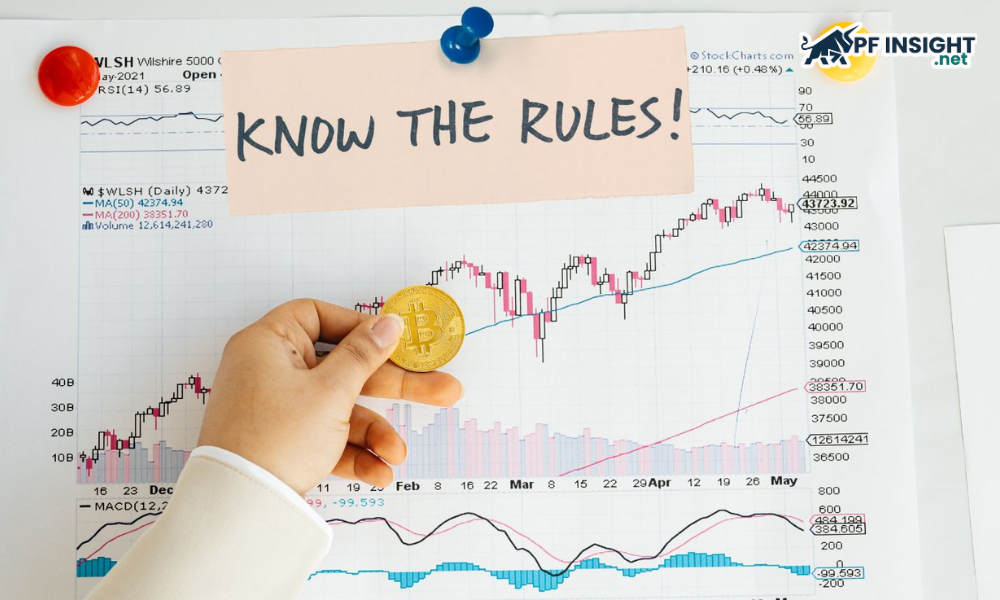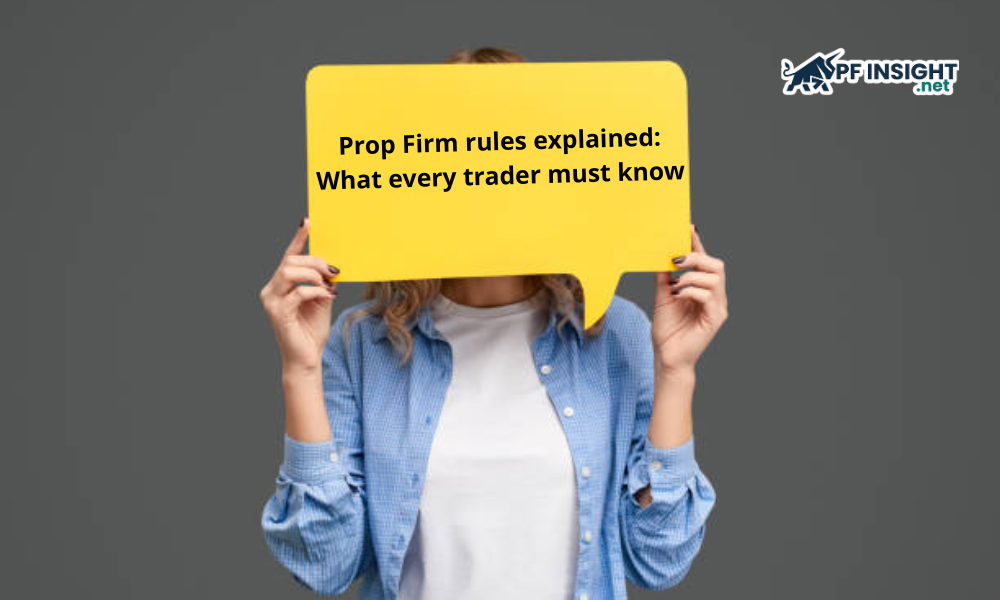Understanding the rules of proprietary trading firms can feel like trying to solve a complex puzzle. These rules, though intricate, are essential for traders who aim to secure a funded account. In this article, PF Insight will have the Prop Firm rules explained, giving you a smoother start to your trading career.
What are Prop Firm rules?
Prop Firm rules are a set of rules established by a proprietary trading firm to govern how traders manage their accounts. These are more than just limits, they are a measure of discipline, risk management, and trading sustainability. If a trader fails to comply with these rules, the account will be terminated, even if there is no profit violation. Therefore, understanding the Prop Firm rules is the first step to becoming a successful funded trader.
Why do Prop Firms have rules?

Proprietary trading firms impose many regulations to protect their capital from risky strategies and to screen out those with real skills. By using these rules, the firm can find disciplined traders who manage their risk effectively instead of relying on luck alone. For this reason, they create a set of rules to:
- Protecting corporate capital: Regulations are in place to prevent traders from trading beyond their permitted risk thresholds, helping to prevent significant losses that could impact capital. This helps businesses maintain financial stability while also encouraging traders to adopt strict and long-term risk management measures.
- Trader assessment: The company can accurately assess a trader’s capital management, discipline, and trading style by setting challenges with specific parameters such as profit targets, loss limits, and trading time. This is an important criterion when choosing a trader worthy of sponsorship.
- Encourages discipline: Prop Firm rules explaining risk, profit or trading volume will help traders form safe trading habits over time and prevent emotions from taking over. This helps traders build a more professional and long-term trading style, while protecting the account.
- Maintaining sustainability: Firms can ensure that excessive loss-making trades do not affect capital flows by implementing strict risk management principles. As a result, Prop Firm can maintain stable operations and continue to expand its funding capacity for traders, promoting a fair and sustainable trading environment.
Common Prop Firm rules explained
Prop Firm rules explained to ensure traders stay disciplined and can earn consistent profits. Here are the main rules you need to keep in mind when engaging in proprietary trading.

Minimum number of trading days
For any trader, consistency in trading is essential. To ensure that you are not relying solely on luck, some firms have a minimum number of trading days. Even if you hit your profit target early, say in 7 days but the rule says 10 days, you still have to continue trading for another 3 days. Prop Firm rules explain that it is your ability to maintain a consistent strategy, proving that you have real skill and not just a few big wins.
Profit target
Most proprietary trading firms set profit targets in their assessment program based on a percentage of account value. This is usually between 5% and 10%. For example, you must earn $2,500 during the challenge period if you manage a $50,000 account with a 5% profit requirement. Completing the target proves that you are not only profitable but also know how to maintain consistency in trading over the long term.
Withdrawal limits
The basic principle of trading at Prop Firms is to control losses. They often set maximum loss limits, including daily and total losses, to protect capital. For example, a firm may stipulate that you are only allowed to lose 2% per day and a maximum of 5% overall. Your account will be closed immediately if you exceed this limit. In addition to protecting the company’s capital, Prop Firm rules also guide traders on how to trade more disciplinedly and apply safer risk management measures.
- Daily loss limit: One of the most important rules of Prop Firm in terms of capital protection and risk management is the daily loss limit. This rule sets the maximum loss a trader can suffer in a day. If the allowed amount is exceeded, the account may be stopped or the right to continue trading may be lost. This limit will be updated at the end of the day, usually 21:00 UTC, and usually ranges from 3% to 5% of the account balance.
- Maximum withdrawal limit: Setting maximum withdrawal limits acts as a safety measure to minimize risk for both the proprietary trading firm and the trader. These limits usually include the total loss from the peak value of the account as well as the maximum daily loss. Since most traders experience drawdowns when trading, it is important to understand these rules.
Prohibited trading styles and strategies
Proprietary trading firms often publish lists of prohibited strategies to minimize risk and prevent market manipulation. Prohibited strategies include grid trading, excessive speculation, late arbitrage, high-frequency trading, and Martingale strategies. These methods often rely on volatility or gambling rather than reflecting the trader’s actual analytical and trading abilities.
Many proprietary trading firms apply additional risk management restrictions in addition to the basic guidelines. These may include prohibiting the use of Expert Advisors (EAs), limiting weekend holdings, hedging across multiple accounts, copy trading, and not trading during major economic news.
Furthermore, excessive leverage – for example, more than 70% of the available margin – is dangerous and can lead to a breach. The Prop Firm is also concerned about overtrading. The system will flag an account as risky and issue a warning if it executes more than 200 orders or generates more than 2,000 server signals in a day.
How to succeed while following Prop Firm rules
Prop Firm Rules Explained will help you understand how Prop Firms operate and why they have certain rules. Understanding these rules will help you manage your capital more effectively, avoid unnecessary violations, and improve your chances of success. Here are some common mistakes and tips to help you follow the rules:

Top mistakes that cause many traders to fail early:
Excessive leverage: While many people think that opening large trading volumes will help them reach their profit goals faster, the reality is often the opposite. Just a few pips of error can wipe out an entire account when the market moves against you. To increase your chances of success, you should prioritize stability and careful capital management over excessive risk.
- Ignoring the rules: Many people do not take the time to read the terms and conditions, which leads to violations of seemingly small details. A single mistake such as exceeding the trading limit, holding an order at the wrong time or using a prohibited strategy can result in an immediate loss of the account. Therefore, it is essential to understand and follow the rules.
- Emotions dominate trading: When they lose, they tend to “take revenge on the market”, which happens when they place orders in a hurry or buy and sell without thinking because of FOMO. To quickly recoup their losses, some people even double their trading volume, but this often leads to loss of control and breaking the rules.
- Not keeping a trading Journal: Ignoring this tool prevents them from analyzing bad decisions or developing effective strategies from winning trades. Lack of journaling means lack of data to improve, making the development process slow and prone to repeating old mistakes.
- Not setting a stop loss: They hope the market will move in their favor instead of accepting small losses and protecting their account. This mentality often leads to losses that grow far beyond their limits. Eventually, just one uncontrolled trade can ruin the whole ordeal.
Tips for completing Prop Firm challenges:
- Focus on risk management: One of the most effective risk management strategies is to limit each trade to 1-2% of your account value. This rule helps you avoid drawdowns, maintain capital safety, and avoid exceeding the company’s drawdown limit.
- Trade with a plan: Traders must clearly define the maximum number of orders placed per day, the trading volume for each order and the acceptable level of risk. Furthermore, setting a stop when reaching a loss limit or profit target will help control emotions and maintain discipline throughout the process.
- Avoid overtrading: Many traders lose their accounts simply because of overtrading, that is, trading too much without a clear plan. Continuously entering orders to chase profits makes traders lose control of their emotions, increases risk and easily violates money management rules. Instead, focusing on a few high-quality trading opportunities will increase efficiency and maintain long-term sustainability.
- Respect the rules: Instead of looking for ways to “bend the rules” during the Prop Firm challenge, traders should see this as an opportunity to practice discipline. These rules are not only to assess risk management ability but also to form safe and sustainable trading habits. Strict compliance will help you improve your skills and better prepare for the real trading journey outside the Prop Firm.
Conclusion
Understanding Prop Firm rules explained is an important step to becoming a successful funded trader. These rules can be stressful, but they also help traders practice discipline, manage risk, and develop a sustainable strategy. If you want to join a Prop Firm, start by carefully studying the rules, choosing a firm that fits your trading style, and most importantly: always be disciplined.







